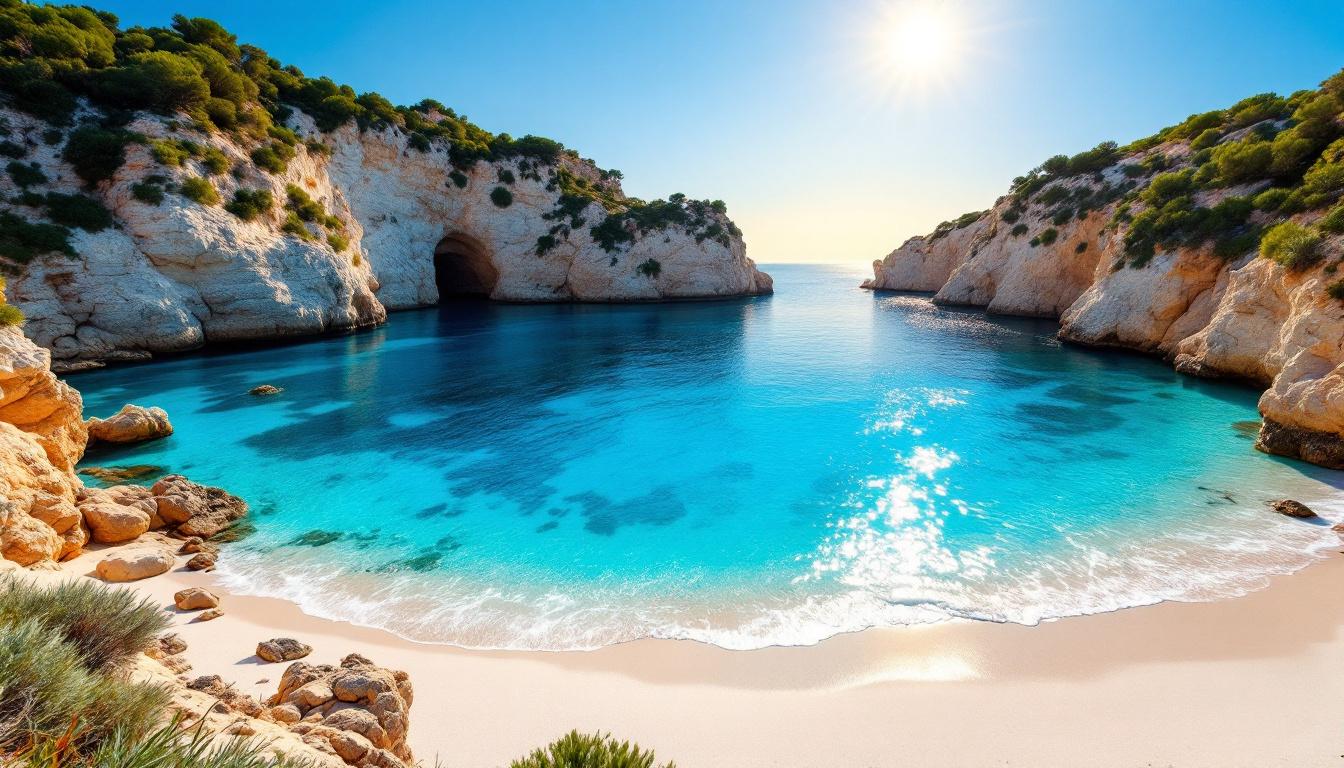The turquoise waters of Cala Turqueta shimmer like liquid sapphire against Menorca’s rugged southwestern coast, but this 48-meter slice of Mediterranean paradise faces a growing threat. Local authorities have implemented car access restrictions from June through September, desperately trying to protect what residents call their “secret jewel” from Instagram’s relentless exposure.
Unlike the overcrowded beaches of Mallorca and Ibiza, where 10 million and 3.5 million tourists respectively flood the shores annually, Menorca receives only 1.5 million visitors. Yet even this smaller number threatens places like Cala Turqueta, where car parks now fill by 7:30 AM during peak season and the delicate coastal ecosystem shows signs of strain.
The protective measures aren’t just bureaucratic red tape—they represent a community’s desperate attempt to preserve something irreplaceable. Walking the 30-minute trail to reach this hidden cove, you understand why locals fight so fiercely to keep their sanctuary intact.
Why Menorcan communities guard their coastal treasures
The Instagram effect destroying pristine beaches
Environmental group GOB Menorca reports alarming erosion rates along Cala Turqueta’s access paths, directly attributed to increased foot traffic from social media discoveries. What was once a quiet family beach now sees crowds expecting the perfect photo opportunity, often leaving disappointed when reality doesn’t match the filtered fantasy.
Local families losing their weekend refuges
Maria Cardona, a Ciutadella resident for forty years, describes arriving at “her” beach to find no parking spaces and crowds of tourists where her children once played freely. “We’re not against visitors,” she explains, “but we’re losing the places that define our island identity.”
Environmental protection measures locals demanded
Vehicle restrictions saving fragile ecosystems
The Menorca Biosphere Reserve status empowers local authorities to limit vehicle access during peak months. Unlike other Balearic destinations prioritizing tourism revenue, Menorca chose environmental preservation, implementing a “2-for-1” accommodation policy that removes two old tourist beds for every new one added.
Plastic-free initiatives protecting marine life
TUI Care Foundation and Menorca Preservation collaborate on removing 17,800 kg of plastic waste annually from coastal areas including Cala Turqueta. Local businesses earn “Plastic Free Balearics Certification” by eliminating single-use plastics, creating an authentic sustainable tourism model that residents actively support.
What makes this different from overtouristed alternatives
Menorca’s preservation culture versus mass tourism
While Mallorca accommodates 84,000 hotel beds and Ibiza promotes party tourism, Menorca caps accommodations and encourages slow tourism. The island’s rural heritage emphasizes hiking, birdwatching, and cultural immersion over beach clubs and nightlife, attracting visitors who respect local values.
Community-controlled access ensuring authenticity
The 15-minute walk from restricted parking areas isn’t punishment—it’s preservation. This gentle barrier filters out casual visitors while welcoming those genuinely interested in Menorca’s natural beauty. The tiny Italian peninsula locals call the “Maldives of Salento” employs similar protective strategies, proving Mediterranean communities can balance tourism with preservation.
How respectful visitors can still experience paradise
Trail etiquette honoring local traditions
The Camí de Cavalls coastal path offers legitimate access to Cala Turqueta while respecting environmental limits. Visitors should carry water, wear proper footwear, and follow Leave No Trace principles. Early morning or late afternoon visits reduce impact while providing better photography conditions than harsh midday sun.
Supporting local conservation efforts
Participating in upcycling workshops or beach clean-up activities transforms visitors from tourists into temporary environmental stewards. Honduras beaches implementing visitor caps show similar community engagement programs working effectively. Local restaurants featuring Menorcan cuisine and wines create authentic cultural exchanges while supporting island economy.
Planning your visit to support preservation
Respect the June-September vehicle restrictions by using public transport or designated hiking trails. Book accommodations with “Plastic Free Balearics Certification” and choose authentic local experiences over commercialized attractions.
Cala Turqueta represents more than a beautiful beach—it’s a community’s commitment to preserving natural heritage for future generations. Visit respectfully, and you’ll understand why locals fight so passionately to protect their island paradise from becoming another overcrowded Mediterranean casualty.
Essential information for conscious travelers
When can I visit Cala Turqueta?
The beach is accessible year-round, but vehicle restrictions apply June-September. Arrive early (before 9 AM) or visit during shoulder seasons for easier access and fewer crowds.
How do I get there without a car during restrictions?
Public buses operate from Ciutadella to nearby parking areas, followed by a 30-minute coastal walk. The trail is well-marked and suitable for moderate fitness levels.
What makes Menorca different from other Balearic Islands?
Menorca receives 1.5 million annual visitors compared to Mallorca’s 10 million, maintaining its UNESCO Biosphere Reserve status through careful tourism management and community-supported conservation measures.
Are there similar protected beaches on the island?
Yes, Cala Macarella and Cala Mitjana have similar restrictions. The island’s commitment to preservation means multiple beaches maintain authentic Mediterranean character through visitor management.
How can I support local conservation efforts?
Choose certified sustainable accommodations, participate in beach clean-ups, buy from local producers, and respect all environmental guidelines. Your conscious choices directly support the community’s preservation efforts.
